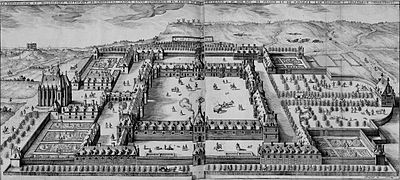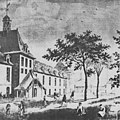Hôpital Saint-Louis

The Hôpital Saint-Louis is a hospital in Paris . It is located in the 10th arrondissement and is now part of the public hospital association Assistance publique - hôpitaux de Paris (AP-HP). It was built from 1607 and takes up an entire street. Entrances to the site are 2, place du Docteur-Alfred-Fournier and 1, avenue Claude-Vellefaux. The nearest metro stations are Colonel Fabien and Goncourt on lines 2 and 11 .
history
The Saint-Louis Hospital was built on the order of the French King Henry IV on May 19, 1607 and was part of a previous expansion program for the capital after the destruction of the French Wars of Religion . The idea of a plague hospital had been discussed but not implemented since King Francis I. The plague sufferers were cared for together with other sick people in the Hôtel-Dieu . As the plague epidemics broke out in Paris in 1596, 1605 and 1606 , it was recognized that the sick had to be isolated. A slightly raised area was chosen outside the city wall and financing was secured by increasing the salt tax . The foundation stone was laid on July 13, 1607 and the plague hospital was named after Louis the Saint , who died of the plague in 1270. In the 17th century the hospital was only open during the plague; H. In operation in 1619, 1623, 1625, 1628, 1636 and 1638, and the staff was provided by the Hôtel-Dieu. After the Hôtel-Dieu burned down in 1772, the Hôpital Saint-Louis was used permanently. From 1801 the Hôpital Saint-Louis became a special hospital for skin diseases .
architecture
The engineer and royal architect Claude Chastillon drafted the plans, and the architect, commissioned by the Hôtel-Dieu, Claude Vellefaux directed the construction. Four 120-meter-long buildings are grouped around a central, rectangular and green inner courtyard. The corner buildings have a tower-like structure and the whole complex was surrounded by a garden and enclosed by a wall, so that no one could go in or out without being checked. Smaller outbuildings were built for the nuns , carers and other staff. This area, which also housed the kitchens, a bakery and other facilities, was specially separated from the hospital by a wall. The sick were provided with everything they needed through a guarded passage. The chapel , which was the first building to be completed in 1610, is located on the perimeter wall so that it could be entered from outside as well as from the hospital area. There was also a garden for medicinal herbs and a cemetery on the hospital grounds . The sick were housed in four eight-meter-high dormitories and had no contact with the outside world.
Current condition
Since the 19th century, the Hôpital Saint-Louis has developed into an internationally recognized specialist hospital for dermatology, venereology and hematology . The following well-known doctors worked in the hospital: Jean-Louis Alibert , Jean Guillaume Lugol , Jean Dausset (1980 Nobel Prize in Physiology or Medicine ) and Jean Bernard . Paul Verlaine , Henri de Toulouse-Lautrec and August Strindberg were among the most famous patients .
In the 19th and 20th centuries, numerous outbuildings were built, which greatly changed the overall architectural impression. While the old main building under monument ( monument historique ) was placed, began in 1974 under the direction of the architects Daniel Badani and Pierre Roux-Dorlut to build on the northern area a modern hospital.
Picture gallery
- The listed part of the hospital:
literature
- Jean Colson / Marie-Christine Lauroa (eds.): Dictionnaire des monuments de Paris . Editions Hervas, Paris 2003 (1st edition 1992), ISBN 2-84334-001-2 .
- Laure Beaumont-Mallet: Vie et histoire du Xe arrondissement , Editions Hervas, Paris 1991 (1st edition 1988), ISBN 2-903118-35-3 .
Web links
- Hôpital Saint-Louis: Description as Monument historique in the Base Mérimée of the French Ministry of Culture (French text)
- Official website of the Hôpital Saint-Louis .
Individual evidence
- ^ Hilary Ballon: The Paris of Henri IV. Architecture and Urbanism. MIT Press, Cumberland RI 1994, ISBN 0-262-52197-0 , Chapter IV: The Hôpital Saint-Louis .
Coordinates: 48 ° 52 ′ 29 ″ N , 2 ° 22 ′ 6 ″ E





